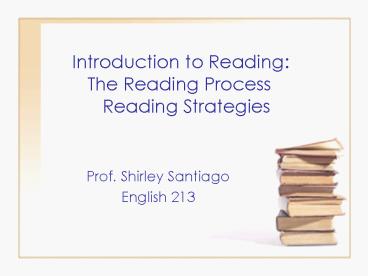Introduction to Reading: The Reading Process Reading Strategies PowerPoint PPT Presentation
1 / 19
Title: Introduction to Reading: The Reading Process Reading Strategies
1
Introduction to Reading The Reading Process
Reading Strategies
- Prof. Shirley Santiago
- English 213
2
What is reading?
- Reading is a process.
- On the simplest level, it is the act of
recognizing and understanding written or printed
verbal symbols (that is, receiving and sorting
out information from the printed word.)
Making meaning
3
At this level, reading is
- Decoding
- (Word Perception)
- Comprehension
- Knowledge of
- Vocabulary
- Sentence structure
- Subject matter
4
At a more complex and active level, reading
involves
- Reacting to the ideas presented by the author
- (based on your feelings and past experiences)
- Integrating new ideas into your personal
perspective - Applying these ideas to daily activities
5
The Reading Process
- Decoding (Word Perception)
- Comprehension
- Reaction to ideas
- Integration
- Application
6
As you become a more skillful reader, you will
realize that reading
- Has many purposes
- Pleasure (to entertain)
- Study (to inform)
- General knowledge
- Persuade
- Convince
- Includes higher skills
- Interpret
- Summarize
- Evaluate
7
Integration On Reading Trash
- What do you consider trash to be?
- Read the selection. Focus on
- who the author is
- his purpose for writing
- the audience he is writing for.
8
Integration On Reading Trash
- What is the central theme? (Bob Swifts bottom
line) - If you want kids to be omnivorous readers, let
them read trash.
9
Application Reading Reaction 1
- Answer questions 11 and 12. In addition, answer
this question - Have you ever been influenced positively by
reading trash? Explain and give concrete
examples.
10
Application Supplementary Readings
- Choose one of the following articles as your
supplementary reading - How Comics Can Reach Reluctant Readers
- http//bookshelf.diamondcomics.com/RELUCTANT_READE
RS.htm - Battle of the Books
- http//www.slate.com/id/2121022
- Improving the Reading Skills of Adolescents
- http//www.nea.org/teachexperience/readk040131.htm
l - Reading Trash A Confession
- http//www.spotsoftime.net/entries/00000004.html
11
Application Supplementary Reading
- After reading the article you chose, answer how
the supplementary reading is related to the
original reading and what your particular
reaction is (what did you learn). - Due 213-01 Wed., Feb. 5
- 213-02 Thurs., Feb. 1
12
Review
- What is reading?
- On a more complex level, what does it involve?
- According to Swift, how can you become an
omnivorous reader?
13
Integration Stephen Covey and The Seven Habits
of Highly Effective People
- Who is Stephen Covey?
- What is the purpose of his book?
- What is a habit?
- A pattern of repeated behavior
14
Integration Summary of The Seven Habits
- Habit 1 Be Proactive
- Habit 2 Begin with the End in Mind
- COMMITMENT
- Habit 3 Put First Things First
- Habit 4 Think Win/Win
- CONCENTRATE
15
Integration Summary of The Seven Habits
- Habit 5 Seek First to Understand, Then to Be
Understood - Habit 6 Synergize
- Habit 7 Sharpen the Saw
- BE ACTIVE
16
The 3 Habits of an Effective Reader
- Commit to reading
- Concentrate on your reading
- 3. Read actively
17
Habit 1 Commit to Reading
- Commitment is action
- Only YOU can improve your reading skills
- PRACTICE
- Have a goal in mind
- Have good habits
18
Habit 2 Concentrate on Your Reading
- Use strategies
- BEFORE you begin reading
- WHILE you are reading
- EFFECTIVE READING REQUIRES PREPARATION
19
Habit 3 Read Actively
- Understand and implement the process
- Employ a plan or strategy that will
- Prepare you before reading
- Improve comprehension while you read
- Help you retain information and ideas
- Allow you to fulfill your purpose for reading

